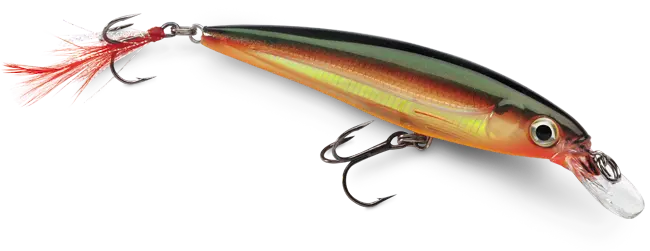Smallmouth Bass: Techniques - Jerkbaits
Table of Contents
- Smallmouth Bass Fishing with Jerkbaits
- Overview of Jerkbaits
- Selecting the Right Jerkbait
- Colors and Sizes
- Popular Brands
- Rigging Jerkbaits
- Basic Rig
- Weighted Rigs
- Specialized Rigs
- How to Fish Jerkbaits for Smallmouth Bass
- Retrieve Techniques
- Tips to Entice Strikes
- Recommended Gear
- Rod
- Reel
- Line
- Community and Expert Tips
- Bass Angler Insights
- Popular Search Terms Related to Jerkbaits
Smallmouth Bass Fishing with Jerkbaits

Overview of Jerkbaits
Jerkbaits are a favorite among bass anglers due to their ability to mimic injured baitfish with realistic, erratic action. Their unique design and darting movements create an irresistible target for predatory fish like smallmouth bass. When fished correctly, jerkbaits can trigger aggressive strikes by provoking a predatory response. Here’s why they work and how they’re generally fished:
- Realistic Action: The intermittent pauses and sharp twitches simulate injured prey, drawing strikes from bass that are hunting.
- Versatility: They can be fished in various water conditions—from clear to stained water—making them a reliable option year-round.
- Depth Range: Depending on the design, jerkbaits can suspend at different depths, enabling anglers to target bass that are holding at various levels.
Selecting the Right Jerkbait
When choosing jerkbaits for smallmouth bass, consider the following factors:
Colors and Sizes
- Natural Colors: Silver, white, and blue patterns mimic common baitfish. In clearer water, these colors work best.
- Bold Colors: In stained or murky water, opt for bright colors like chartreuse, orange, or a combination that includes black accents to create a strong silhouette.
- Sizes:
- Small (2-3 inches): Ideal for clear water or smaller bass.
- Medium (3-4 inches): A versatile size for various water conditions.
- Large (4+ inches): Best in murky water or when targeting larger smallmouth bass.
Popular Brands
- Rapala: Renowned for their realistic action and durability.
- Rebel: Offers a wide range of colors and sizes with an emphasis on lifelike movement.
- Strike King: Known for affordability and effectiveness among bass anglers.
- Z-Man: Provides innovative designs that often include soft-body options for a more natural presentation.
Rigging Jerkbaits
Rigging your jerkbait correctly is essential to achieving the desired action. Here are some rigging techniques for various scenarios:
Basic Rig
- Straight Hook-up: Simply attach your jerkbait directly to your leader with an appropriate hook. This method is ideal for clear water when you want the bait’s natural action to shine through.
Weighted Rigs
- Adding Weight: In deeper water or when bass are holding low, use a weighted jig head to sink your jerkbait to the desired depth. This also enhances the darting action.
- Split-Rigging: Combine a jerkbait with a spinner or soft plastic trailer to create extra vibration, making it irresistible in murkier conditions.
Specialized Rigs
- Carolina Rig Adaptation: For cover or heavy vegetation, rig your jerkbait on a Carolina rig to allow it to bounce off structure without getting snagged.
- Flipping/Rolling Rigs: When fishing close to shore or in tight cover, use a lighter setup with a fast retrieval to imitate a fleeing baitfish.
How to Fish Jerkbaits for Smallmouth Bass
Retrieve Techniques
- Steady Retrieve: A constant, moderate pace works well when bass are actively feeding. The continuous movement simulates a fleeing baitfish.
- Stop-and-Go Retrieve: Alternate between a slow retrieve and brief pauses. The sudden stops often trigger a predatory strike by simulating a wounded baitfish.
- Twitching Retrieve: Incorporate sharp, erratic twitches into your retrieve. This can be especially effective in cooler water or when bass are less active.
Tips to Entice Strikes
- Vary Your Pace: Smallmouth bass can be finicky. If one retrieve isn’t eliciting strikes, vary your speed or add extra twitches.
- Use a Sensitive Rod Tip: A rod with a sensitive tip will help you detect subtle strikes during a stop-and-go retrieve.
- Watch the Water: Adjust your retrieve based on water temperature and clarity—faster retrieves in warmer, murkier water, and slower, more deliberate retrieves in cooler, clearer conditions.
Recommended Gear
Rod
- Length: 6’6” to 7’ for better casting distance and control.
- Action: Medium to medium-light; sensitive enough to detect strikes yet strong enough for the occasional hard hit.
Reel
- Type: Spinning reels are popular for their versatility and ease of use.
- Gear Ratio: A higher gear ratio (6:1 or higher) is beneficial for quick retrieves and sudden bursts.
Line
- Test Strength: 8-12 lb braided or fluorocarbon line is common, balancing sensitivity with durability.
- Fluorocarbon Leader: Consider a 20-30 lb test leader for abrasion resistance, especially when fishing in rocky areas.
Community and Expert Tips
Bass Angler Insights
- Timing is Key: Many experts suggest fishing jerkbaits during low-light conditions—early morning or late afternoon—when smallmouth bass are most active.
- Experimentation: Veteran anglers recommend switching between different retrieves throughout the day. If the stop-and-go retrieve isn’t working, try a more consistent pace.
- Local Knowledge: Join local bass angling forums and groups. Experienced anglers in your area can provide insights on which jerkbait colors and rigs work best for local smallmouth bass.
- YouTube Learning: Check out tutorials from expert bass anglers. One highly recommended video can be found below:

Click the thumbnail to watch a detailed guide on fishing jerkbaits for smallmouth bass.
For more tips, search YouTube for “fishing jerkbaits tips”.
Popular Search Terms Related to Jerkbaits
| Search Term | Thumbnail | Link |
|---|---|---|
| Jerkbait Retrieve Techniques |  |
Watch Video |
| Jerkbait Rigging Tips | Watch Video | |
| Smallmouth Bass Jerkbait Tips | Watch Video | |
| Best Jerkbait Colors & Sizes | Watch Video | |
| Effective Jerkbait Fishing Techniques | Watch Video |
Ask AI for More Info
Try our AI assistant for free—sign up to access this powerful feature.
👉 Sign Up to Ask AI